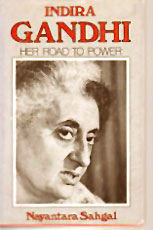 `Indira Gandhi: Her Road to Power` is a piece of work by Nayantara Sahgal. Indira Gandhi`s movement in relation to Indian politics is clearly depicted in the story. The title of the story aptly describe it as this story narrates all the movement or journey of Indira Gandhi and her way to get the power and also return to power after a period of time.
`Indira Gandhi: Her Road to Power` is a piece of work by Nayantara Sahgal. Indira Gandhi`s movement in relation to Indian politics is clearly depicted in the story. The title of the story aptly describe it as this story narrates all the movement or journey of Indira Gandhi and her way to get the power and also return to power after a period of time.
Nayantara Sahgal was born in 1927 into a political family in India. India`s first Prime Minister Jawaharlal Nehru was her uncle. Her mother was the country`s first ambassador to the U.N. Indira Gandhi was her first cousin. She was educated in Lucknow and Wellesly College. She did her graduation in 1947. She served as India`s Ambassador to Italy for a short while when Indira Gandhi was thrown out of power in the elections after the Emergency.
Sahgal`s unique upbringing enriches her culture and the effect is very much prominent in both of her fiction and her political writing. Her novels are often set against the backdrop of pivotal events in Indian history. The author`s father was a successful barrister and classical scholar who translated the Kashmiri epic history Raj Tarangini into English from Sanskrit. His teachings also enlightens the author in a great way. Sahgal has been married twice in her lifetime. Her second marriage was with E.N. Mangat Rai, a Punjabi Christian who was a distinguished Indian Civil Service officer. Rai died at the age of 87 in 2003 in Dehradun. Sahgal is continuing with her work and still doing her job successfully.
Synopsis:
 `Indira Gandhi: Her Road to Power` by Nayantara Sahgal primarily focuses on the political life of Indira Gandhi. According to the author, Gandhi`s values differed from those of her father Jawaharlal Nehru and Lal Bahadur Shastri, both of whom were her predecessors. Therefore, her style in dealing with politics was contrary to theirs. To her predecessors, democracy was very important for the growth and development of the nation. Even though Indira Gandhi believed that she was democratic, she did not continue that democratic belief of her father and Shastri. The author of this book Nayantara Sahgal stresses the fact that Gandhi created a highly centralized government under her command. This can be best seen in the Emergency of 1975-1977. According to the author, the emergency formed a one-party system, strong executive powers, and dynastic succession. The writer also claims that Gandhi returned back to power in 1980 in order to save Sanjay, one of her sons. Indira felt that the only way to rid the charges against him was to again become prime minister. This book is very interesting for the readers as the important reason behind this is the author is related to Gandhi. It provides insight into the political life of Indira Gandhi, as the author is not afraid to express her criticism of Gandhi. She also provides a useful list of Indian personalities and a clear definition of these people. In addition, the writer translates a handful of Indian words to assist the reader when reading. This is a worth reading book with clear picture of Indian politics with special reference to Indira Gandhi`s dynasty.
`Indira Gandhi: Her Road to Power` by Nayantara Sahgal primarily focuses on the political life of Indira Gandhi. According to the author, Gandhi`s values differed from those of her father Jawaharlal Nehru and Lal Bahadur Shastri, both of whom were her predecessors. Therefore, her style in dealing with politics was contrary to theirs. To her predecessors, democracy was very important for the growth and development of the nation. Even though Indira Gandhi believed that she was democratic, she did not continue that democratic belief of her father and Shastri. The author of this book Nayantara Sahgal stresses the fact that Gandhi created a highly centralized government under her command. This can be best seen in the Emergency of 1975-1977. According to the author, the emergency formed a one-party system, strong executive powers, and dynastic succession. The writer also claims that Gandhi returned back to power in 1980 in order to save Sanjay, one of her sons. Indira felt that the only way to rid the charges against him was to again become prime minister. This book is very interesting for the readers as the important reason behind this is the author is related to Gandhi. It provides insight into the political life of Indira Gandhi, as the author is not afraid to express her criticism of Gandhi. She also provides a useful list of Indian personalities and a clear definition of these people. In addition, the writer translates a handful of Indian words to assist the reader when reading. This is a worth reading book with clear picture of Indian politics with special reference to Indira Gandhi`s dynasty.
`Indira Gandhi: Her Road to Power` was published by Ungar publication house in the year of 1982 which clearly depicts Indira Gandhi`s way to lead the country.
`Indira Gandhi: Her Road to Power` is a unique creation of the Sahitya Akademi and the Commonwealth Writers Award winner writer Nayantara Sahgal. This includes the journey of Indira Gandhi in the backdrop as Indian independence. Her differences in thoughts with her father Jawaharlal Nehru and Lal Bahadur Shastri regarding politics is also clearly narrated in the story which at times creates a lot of interest to the reader.



















